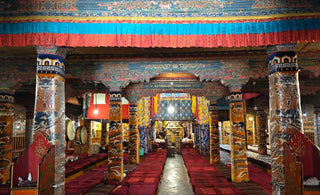
Introduction:
Thangka art, rooted in the rich cultural and religious tapestry of Tibet, has undergone a fascinating transformation in contemporary times. This traditional form of scroll painting, once confined to religious contexts, has evolved into a dynamic and innovative expression of cultural identity and artistic exploration. In this exploration, we will delve into five key aspects that illuminate the current landscape of Thangka art, showcasing the works of contemporary artists and the innovative strides within this ancient tradition.
1.Historical Context of Thangka Art:
To truly appreciate the contemporary developments in Thangka art, a brief historical overview is essential. Thangkas have been integral to Tibetan Buddhism, serving as visual aids for meditation and tools for conveying spiritual narratives. Understanding this historical context provides a foundation for exploring how artists today build upon and reinterpret the traditional techniques and themes.
2.Masters of Tradition:
The lineage of Thangka art is marked by a succession of masters, each passing on the secrets of the craft to the next generation. One such luminary is [Master's Name], whose contributions have become synonymous with the highest standards of Thangka craftsmanship. Through a meticulous study of religious texts, apprenticeship, and years of practice, these masters have achieved a profound understanding of the spiritual significance embedded in every stroke of the brush.
One cannot delve into Thangka art without acknowledging the paramount importance of brushwork. Masters of Tradition engage in a dance of devotion with their brushes, executing lines and details with unparalleled precision. Every stroke carries not just the weight of artistic expression but also a profound spiritual resonance. It is through the delicate dance of the brush that these artists bring to life the celestial realms depicted in Thangka paintings.
Despite the modernization of Thangka art, there remains a cohort of artists dedicated to preserving and perpetuating the traditional techniques. This section will introduce renowned masters who have mastered the intricate brushwork, color palettes, and religious symbolism inherent in Thangka painting. Examining their work sheds light on the nuanced balance between preserving tradition and adapting to contemporary artistic sensibilities.
3.Contemporary Thangka Artists:
The heart of our exploration lies in the examination of contemporary artists who push the boundaries of Thangka art. These artists infuse their creations with personal narratives, socio-political commentary, and a broader range of themes beyond religious iconography. Case studies of prominent contemporary Thangka artists will showcase how they navigate between tradition and innovation, using the ancient canvas to explore contemporary issues.
As guardians of tradition, these masters face a delicate challenge — preserving the sanctity of Thangka art while acknowledging the evolving currents of contemporary sensibilities. Examining their work reveals a nuanced balance, where tradition serves as a foundation, and innovation becomes a subtle embellishment. The adaptability of these masters is a testament to the timelessness of Thangka art, capable of resonating across epochs without losing its spiritual resonance.
4.Innovations in Technique and Materials:
Thangka art, traditionally executed on cotton or silk, has witnessed innovations in materials and techniques. Contemporary artists experiment with unconventional canvases, pigments, and even digital tools, expanding the possibilities of expression while respecting the essence of Thangka aesthetics. This section will delve into these innovations, highlighting how they contribute to the evolution of the art form.
Religious symbolism is the heartbeat of Thangka art, and the masters navigate a vast sea of symbols with profound insight. Each deity, gesture, and object carries layers of meaning, and these masters decode and infuse these symbols with spiritual significance. Their work becomes a bridge between the earthly realm and the divine, inviting viewers to embark on a contemplative journey through the sacred iconography of Thangka painting.
5.Global Influence and Cross-Cultural Dialogues:
The global dissemination of Thangka art has led to cross-cultural exchanges and collaborations. Artists from diverse backgrounds are engaging with Thangka traditions, bringing fresh perspectives and influences into the artistic discourse. By exploring instances of cross-cultural dialogues, we gain insights into how Thangka art has become a dynamic, global phenomenon, transcending its geographical and cultural origins.
In a world marked by rapid change, the relevance of traditional mastery in Thangka art extends beyond nostalgia. It is a living tradition that continues to inspire contemporary artists, providing a timeless reference point for those seeking to understand the spiritual depth embedded in the strokes of a Thangka master. The works of these traditional custodians serve as a source of inspiration, a reminder that the essence of Thangka art transcends the constraints of time.
Conclusion:
The Masters of Tradition in Thangka art stand as living legends, weaving a tapestry that spans centuries and bridges the sacred with the secular. Their dedication to preserving the intricate techniques, vibrant color palettes, and profound religious symbolism ensures that Thangka art remains not only a visual feast but also a spiritual odyssey. As we peer into the world of these masters, we glimpse the eternal dance of tradition and innovation, a dance that continues to unfold across the canvas of time, enriching the cultural heritage of Tibet and captivating the hearts of art enthusiasts worldwide.
In conclusion, Thangka art today stands at the crossroads of tradition and innovation, with contemporary artists navigating a delicate balance between preserving the ancient techniques and exploring new horizons. The evolution of Thangka art reflects not only artistic ingenuity but also the resilience of cultural heritage in the face of a rapidly changing world. As we continue to witness the unfolding of Thangka art in the 21st century, it becomes evident that this ancient tradition is not only alive but thriving in the hands of visionary artists who carry its legacy into the future.























